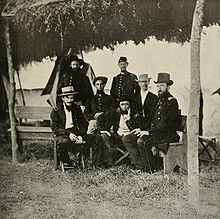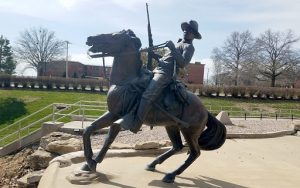That Other Cavalry Guy: Benjamin H. Grierson

April is a significant month in Civil War history. Some argue that the war both began and ended in Aprils four years apart. Lincoln was assassinated in April. The war’s first really bloody battle—the foreshadowing of what was to come—occurred in April at Shiloh, in Tennessee.
April also marks one of the most decisive mounted operations of the entire war, and certainly one of the most successful raids. Here I am talking about April 1863, when Union Brigadier General Benjamin H. Grierson with 1,700 Illinois and Iowa cavalrymen rode the almost the full length of the state of Mississippi from north to south, departing LaGrange Tennessee on April 17, and riding into Baton Rouge on May 2. 
Designed to distract Confederate Lieutenant General John C. Pemberton, commanding the Confederate defenses of Mississippi (and especially Vicksburg) while Ulysses S. Grant attempted passage of the Mississippi River below the Rebel fortress, Grierson’s expedition proved wildly successful. “We killed and wounded about of the enemy,” Grierson reported, “captured and paroled over 500 prisoners. . . destroyed between 50 and 60 miles of railroad and telegraph . . . over 3,000 stand of arms, and other army stores . . . to an immense amount. We also captured 1,000 horses and mules. Our loss . . . was three killed, seven wounded, five left on the route sick, . . . and nine men missing. We marched over 600 miles in 16 days.”
Even more importantly than the material damage, Grierson diverted an entire infantry division of Pemberton’s forces to try and defend the railroad, while, as historian Tim Smith pointed out, during the five most crucial days of Grant’s campaign, virtually all of Pemberton’s telegraphic message traffic was focused instead on Grierson’s movements.
Few cavalry operations in history have had such a strategic impact. No other Civil War cavalry operation proved as decisive to a larger campaign.
And yet, Benjamin Grierson is not well known to the average Civil War enthusiast. Many have heard of his raid, but few really know about the rest of his career during the war. When stacked against more sensational names like Forrest or Stuart, he fades into the background.
Like Nathan Bedford Forrest, Grierson lacked any professional military background. Born in Pittsburgh Pennsylvania, by the time of the war he was a music teacher and storekeeper in Jacksonville, Illinois, west of Springfield. He began the war as an aide to Union General Benjamin M. Prentiss but was commissioned as a major of the 6th Illinois Cavalry in October 1861. He rose to command the regiment the next April.
Unlike the Union Army of the Potomac in Virginia, the Army of the Cumberland in Tennessee, or their counterparts in Confederate service, Ulysses S. Grant’s Army of the Tennessee never really consolidated its mounted forces into a single corps command. Though the organization existed on paper, it was not used inf the field. Instead, Grant continued to follow the early war practice of attaching smaller cavalry forces to his infantry commands, or scattering them in brigades; as a result, the mounted officers in his army rarely had a chance at higher command.

Grierson, who spent his entire war operating in this theater, never commanded more than a division of cavalry. That does not mean he was sidelined. After his spectacular raid against Pemberton, he served under Nathaniel Banks during the subsequent siege of Port Hudson; and then, in 1864, was involved in repeated efforts to defeat Nathan Bedford Forrest in Mississippi—to mixed success.
Forrest was transferred out of the Confederate Army of Tennessee at his own request in November, 1863; returning to his home state to help defend it in the wake of the Vicksburg disaster. Forrest led a semi-independent cavalry corps of between 8,000 and 10,000 men throughout 1864, facing off against various Union commanders. Forrest’s most spectacular victory, Brice’s Crossroads, was won in June against Union General Samuel Sturgis, with Grierson leading Sturgis’s cavalry force. Badly trounced in that encounter, the Federals fell back to Memphis, only to try again in July. This time the Union commander was A. J. Smith, with Grierson again commanding the cavalry. The Battle of Tupelo, fought in mid-July under a sweltering Mississippi sun, resulted in a Confederate defeat. It severely damaged Forrest’s command and—most importantly—kept Forrest tied down in Mississippi instead of raiding Sherman’s lengthy supply line; the railroad from Louisville to Nashville, Chattanooga, and into North Georgia.

Surprisingly, even though Grierson was a pre-war music teacher and storekeeper with no military experience and an outright fear of horses, he chose to make the army his career after the war. He also undertook to cross the color line, commanding the 10th United States Cavalry Regiment, one of four black regiments (one other cavalry, the 9th, and two of infantry, the 24th and 25th) in U.S. Service after the war. Commanding a Negro regiment came with a certain amount of ostracism from his fellow white officers, but Grierson respected the black troops who fought alongside him in Mississippi during the war, and willingly embraced the command.
Ben Grierson is worth a second look.
Sources:
Timothy B. Smith, The Real Horse Soldiers, Benjamin Grierson’s Epic 1863 Civil War Raid through Mississippi. Savas Beatie, 2018.
Robert H. Leckie, Unlikely Warriors: General Benjamin H. Grierson and his Family. University of Oklahoma Press, 1984.
Bruce J. Dinges and Shirley A. Leckie, eds. A Just and Righteous Cause: Benjamin H. Grierson’s Civil War Memoir. Southern Illinois University Press, 2008.
Diversion. Feint. Raid. Occupation. Skirmish. Battle. During the Civil War these were the most frequent “active operations.” But we tend to focus on battles. Because battles are more interesting and exciting. And even the skirmish (a small battle) is called a “battle,” if the victorious commander can get away with it; and a battle will sometimes be called a “raid” (a brief armed incursion of enemy territory, specifically for inflicting maximum damage and mayhem) by the losing commander of a battle (for example, PGT Beauregard and his attempt to spin the Battle of Shiloh as a “raid,” never intending to hold the ground around Pittsburg Landing, instead of acknowledging defeat in battle.) Two examples of “occupation” are Kellogg Swift’s sudden armed advance with significant numbers to hold Cairo Illinois in April 1861; and Major General Polk’s armed advance into neutral Kentucky in September 1861 to occupy the heights overlooking the Mississippi River at Columbus. The “feint” is a mirage: what appears to be a full-blown operation in one direction, while the real action is designated to take place somewhere else. A feint differs from a “diversion” in that the units involved in a feint often return to base within a day or two of setting out. Soldiers hate to be involved in “feints,” forced marches with no apparent purpose, as they are often not told the true purpose of their activity. Although called a “raid,” Grierson’s ride into Mississippi could easily be labelled “diversion” for Grant’s massive relocation of force to the south of Vicksburg, preparatory to the investment of the Gibraltar of the Confederacy.
Why the importance and significance of terminology? Battles and Raids were always accorded memorialization on unit Battle Flags; feints and diversions were not.
Thank you for sharing a story about valuable assistance to Vicksburg
I love your blog. Great love of country and info!??????
Ben Grierson was seminal to Grant’s success in the Vicksburg Campaign
You are right about Tim Smith’s book…it, like all his works…is excellent.
The first image in the article shows Brevet Major General Jefferson C. Davis. The group image does not include Grierson, but Colonel William J. Landrum (center, misidentified as Grierson) and Brigadier General Albert L. Lee (the guy with straw hat)…
As noted above, the Grierson pictures are mislabeled. The lead picture is of Gen. Jefferson C. Davis, brother of my great-grandfather Wm. Davis who was an officer in the 10th Cav commanded by his wife’s uncle Ben Grierson. Sort of related, but different.
Good article about the real story behind the film “Horse Soldiers” (“Misión de Audaces” in Spanish) which is one of the favorite movies among the hispanic people. .